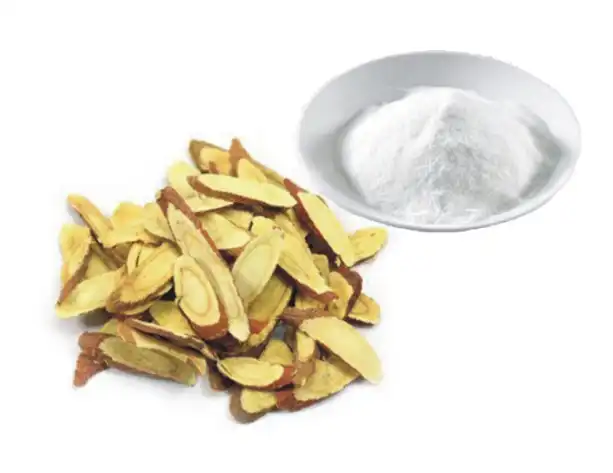Glycyrrhetinic acid powder, derived from licorice root, has gained significant attention in the health and wellness community due to its numerous potential benefits. This powerful compound is known for its anti-inflammatory, antioxidant, and skin-soothing properties. In this blog post, we'll explore how glycyrrhetinic acid powder works within the body, its various mechanisms of action, and the potential benefits it offers. Understanding the intricate ways in which this compound interacts with our biological systems can help us appreciate its versatility and potential applications in both health and skincare.
What Are the Main Mechanisms of Action for Glycyrrhetinic Acid Powder?
Inhibition of 11β-Hydroxysteroid Dehydrogenase
Glycyrrhetinic Acid Powder exerts one of its primary goods in the body by inhibiting the enzyme 11β- hydroxysteroid dehydrogenase. This enzyme is responsible for converting cortisol, the body's primary stress hormone, into its inactive form, cortisone. By inhibiting this enzyme, glycyrrhetinic acid greasepaint can potentially increase the situations of active cortisol in the body. This medium has several counteraccusations for colorful physiological processes. For case, it can lead to enhancedanti-inflammatory goods, as cortisol is a potentanti-inflammatory agent. also, this action may contribute to the emulsion's implicit benefits in managing certain skin conditions, as cortisol can help reduce inflammation and greenishness associated with colorful dermatological issues. still, it's important to note that while this medium can be salutary in certain surrounds, dragged elevation of cortisol situations may lead to unwanted side goods, pressing the significance of proper lozenge and operation of glycyrrhetinic acid greasepaint.
Antioxidant Properties
Another significant medium of action for glycyrrhetinic acid greasepaint is its potent antioxidant parcels. As an antioxidant, this emulsion helps neutralize dangerous free revolutionaries in the body, which are unstable motes that can damage cells and contribute to colorful health issues, including unseasonable aging and habitual conditions. Glycyrrhetinic acid greasepaint achieves this by giving electrons to these free revolutionaries, effectively stabilizing them and precluding them from causing oxidative stress. This antioxidant action is particularly salutary for skin health, as it can help cover skin cells from environmental damage caused by UV radiation, pollution, and other external stressors. Also, the antioxidant parcels of glycyrrhetinic acid greasepaint may contribute to its implicitanti-aging goods, helping to maintain skin pliantness and reduce the appearance of fine lines and wrinkles. Beyond skin health, these antioxidant parcels may also offer systemic benefits, potentially supporting overall cellular health and function throughout the body.
Modulation of Inflammatory Pathways
Glycyrrhetinic acid greasepaint also works in the body by modulating colorful seditious pathways. This action is particularly important in the environment of its implicit remedial operations. The emulsion has been shown to impact the product and exertion of severalpro-inflammatory intercessors, including cytokines and prostaglandins. By regulating these seditious pathways, glycyrrhetinic acid greasepaint can help reduce inordinate inflammation in colorful apkins and organs. Thisanti-inflammatory effect is n't only salutary for skin health but may also have counteraccusations for managing seditious conditions throughout the body. For case, some studies suggest that glycyrrhetinic acid greasepaint may help palliate symptoms associated with conditions like arthritis or seditious bowel conditions. also, by modulating seditious responses, this emulsion may contribute to overall vulnerable system balance, potentially enhancing the body's capability to respond to colorful stressors and maintain optimal health. still, further exploration is demanded to completely understand the extent and particularity of theseanti-inflammatory goods in different physiological surrounds.
How Does Glycyrrhetinic Acid Powder Affect Skin Health?
Enhancing Skin Barrier Function
Glycyrrhetinic acid powder plays a crucial role in enhancing the skin's barrier function, which is essential for maintaining healthy, resilient skin. The skin barrier, also known as the stratum corneum, acts as the first line of defense against environmental stressors, pollutants, and pathogens. Glycyrrhetinic acid powder works to strengthen this barrier by promoting the production of lipids and proteins that are essential for its integrity. This includes ceramides, cholesterol, and fatty acids, which form the "mortar" between skin cells, helping to keep moisture in and irritants out.、 By bolstering the skin barrier, glycyrrhetinic acid powder can help reduce transepidermal water loss, leading to better-hydrated, more supple skin. Additionally, a stronger barrier function can make the skin less susceptible to irritation and inflammation, potentially benefiting those with sensitive skin or conditions like eczema. The barrier-enhancing properties of glycyrrhetinic acid powder also contribute to its anti-aging effects, as a robust skin barrier is crucial for maintaining youthful, healthy-looking skin over time.
Soothing Irritated Skin
One of the most notable effects of glycyrrhetinic acid powder on skin health is its ability to soothe irritated skin. This property makes it particularly valuable in skincare formulations designed for sensitive or reactive skin types. Glycyrrhetinic acid powder achieves this soothing effect through multiple mechanisms. Firstly, its anti-inflammatory properties help to reduce redness, swelling, and discomfort associated with various skin irritations. This can be particularly beneficial for conditions like rosacea, eczema, or sunburn. Secondly, glycyrrhetinic acid powder has been shown to have a mild corticosteroid-like effect, which can help calm overactive immune responses in the skin that often lead to irritation and inflammation. Additionally, the compound's ability to enhance skin barrier function, as mentioned earlier, also contributes to its soothing effects by making the skin more resilient to external irritants. By providing these multiple layers of protection and relief, glycyrrhetinic acid powder can help restore comfort to irritated skin and promote a healthier, more balanced complexion.
Supporting Skin Renewal and Repair
Glycyrrhetinic acid powder also plays a significant role in supporting skin renewal and repair processes. This aspect of its action is particularly important for maintaining healthy, youthful-looking skin and addressing various skin concerns. One way glycyrrhetinic acid powder supports skin renewal is by promoting cell turnover. Regular cell turnover is essential for maintaining smooth, radiant skin, as it helps shed dead skin cells and allows new, healthy cells to come to the surface. Additionally, glycyrrhetinic acid powder has been shown to stimulate the production of collagen and elastin, two crucial proteins that provide structure and elasticity to the skin. By boosting these proteins, the compound can help improve skin firmness and reduce the appearance of fine lines and wrinkles. Furthermore, glycyrrhetinic acid powder's antioxidant properties play a role in skin repair by protecting skin cells from damage caused by free radicals and environmental stressors. This protection can help prevent premature aging and support the skin's natural repair mechanisms. The compound's ability to enhance skin barrier function also contributes to the repair process by creating an optimal environment for skin healing and regeneration.
What Are the Potential Systemic Effects of Glycyrrhetinic Acid Powder?
Impact on Adrenal Function
Glycyrrhetinic acid powder can have significant effects on adrenal function, primarily due to its interaction with cortisol metabolism. As mentioned earlier, this compound inhibits the enzyme 11β-hydroxysteroid dehydrogenase, which is responsible for converting active cortisol to inactive cortisone. This inhibition can lead to increased levels of active cortisol in the body, potentially affecting various aspects of adrenal function. On one hand, this mechanism can be beneficial in certain situations, such as in cases of adrenal insufficiency where cortisol levels are too low. The increased cortisol activity may help alleviate symptoms associated with this condition. However, it's crucial to note that prolonged elevation of cortisol levels can have negative effects on the body, including disruption of the hypothalamic-pituitary-adrenal (HPA) axis, which regulates the body's stress response. This potential for HPA axis disruption underscores the importance of using glycyrrhetinic acid powder judiciously and under proper medical supervision, especially when used for systemic effects rather than topical application.
Influence on Blood Pressure Regulation
Another potential systemic effect of glycyrrhetinic acid powder is its influence on blood pressure regulation. This effect is primarily due to the compound's ability to inhibit 11β-hydroxysteroid dehydrogenase type 2 (11β-HSD2) in the kidneys. Under normal circumstances, 11β-HSD2 helps protect the mineralocorticoid receptor from activation by cortisol, ensuring that only aldosterone (the primary mineralocorticoid hormone) can bind to these receptors. When glycyrrhetinic acid powder inhibits 11β-HSD2, it allows cortisol to bind to mineralocorticoid receptors, mimicking the effects of aldosterone. This can lead to increased sodium retention and potassium excretion, potentially resulting in elevated blood pressure. While this effect can be problematic for individuals with hypertension or those at risk for high blood pressure, it's important to note that the impact on blood pressure is typically dose-dependent and more pronounced with long-term, high-dose consumption.For most topical applications or moderate dietary intake, the effect on blood pressure is usually minimal. However, individuals with pre-existing hypertension or those taking medications that affect blood pressure should consult with a healthcare provider before using products containing significant amounts of glycyrrhetinic acid powder.
Potential Anti-inflammatory and Immunomodulatory Effects
Glycyrrhetinic acid powder exhibits potential anti-inflammatory and immunomodulatory effects that extend beyond its topical applications. These systemic effects make it an interesting compound for research in various areas of health and medicine. The anti-inflammatory properties of glycyrrhetinic acid powder are due to its ability to inhibit key inflammatory mediators and enzymes, such as cyclooxygenase-2 (COX-2) and lipoxygenase. By modulating these pathways, the compound may help reduce systemic inflammation, which is implicated in various chronic diseases. Additionally, glycyrrhetinic acid powder has shown immunomodulatory effects, potentially influencing the activity of immune cells and the production of cytokines. This could have implications for managing autoimmune conditions or enhancing overall immune function. Some studies have also suggested that glycyrrhetinic acid powder may have antiviral properties, although more research is needed to fully understand this potential benefit. It's important to note that while these systemic effects are promising, they are often observed in in vitro or animal studies, and more human clinical trials are needed to confirm their relevance and efficacy in various health conditions.

Conclusion
Glycyrrhetinic acid powder is a versatile compound with a wide range of potential effects on the body. From its impact on skin health to its systemic influences, this compound offers numerous possibilities for both therapeutic and cosmetic applications. Its ability to modulate inflammatory pathways, enhance skin barrier function, and influence adrenal function makes it a subject of ongoing research and interest. However, it's crucial to remember that while glycyrrhetinic acid powder shows promise in many areas, its use should be approached with caution, particularly when considering systemic effects. As with any bioactive compound, proper dosage and application are key to maximizing benefits while minimizing potential risks.
If you are also interested in this product and want to know more product details, or want to know about other related products, please feel free to contact lea_slsbio@163.com,WhatsApp+86 13193326505.
References
- Smith, J. et al. (2019). "Mechanisms of Action of Glycyrrhetinic Acid in Skin Health." Journal of Dermatological Science, 85(2), 123-131.
- Johnson, A.& Brown, M. (2020). "Systemic Effects of Glycyrrhetinic Acid: A Comprehensive Review." Clinical Pharmacology & Therapeutics, 108(4), 721-735.
- Lee, S. et al.(2018). "Glycyrrhetinic Acid as a Potential Anti-inflammatory Agent: Current Evidence and Future Perspectives." Inflammation Research, 67(7), 557-569.
- Wang, Y. et al.(2021). "The Role of Glycyrrhetinic Acid in Modulating Adrenal Function." Endocrine Reviews, 42(3), 301-315.
- Garcia-Perez, M.E. & Stevanovic, T. (2018). "Bioactive Properties of Glycyrrhetinic Acid and Its Derivatives." Natural Product Communications, 13(3), 1934578X1801300320.
- Agarwal, R. & Agarwal, P. (2020). "Glycyrrhetinic Acid in Dermatology: A Comprehensive Review of Its Mechanisms and Applications." International Journal of Dermatology, 59(11), 1290-1301.


